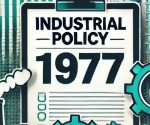The understanding of industrial policy aims to serve purposes such as balanced regional development, promotion of technological innovation and encouraging public and private enterprises. Until recently, India proceeded from a highly controlled regime with licensing and quotas to a liberalized economy, and this greater flux of policy-making has now come to embrace globalization, competitiveness and sustainable industrialization as the new priorities. Having delved into an overall analysis of the meanings, objectives, types, effects, and limitations of industrial policy in India, it is time to explore its dynamism:
What is Industrial Policy of India?
The industrial policy of India is a set of strategic decisions and regulations to promote industrial development. It regulates how industries are set up, how investments enter industries, and how economic resources inter-sectorally are distributed. The policy suggests the functional roles of both public and private enterprises in developing industries. Since independence and under changing global economic conditions, India has moved from a policy of control to one of market liberalization. The core objectives of this policy are employment generation, regional equality, technological growth, and attraction of foreign investments.

Timeline of Industrial Policy in India
The timeline of Industrial Policy in India reflects the nation’s evolving economic priorities and strategic shifts in industrial development since independence. From the early days of a mixed economy emphasizing state control to the liberalization era that opened doors to globalization and private enterprise, each policy has been a response to prevailing socio-economic challenges. This chronological journey highlights how India’s industrial framework has transitioned over the decades to promote modernization, technological advancement, foreign investment, and self-reliant growth. Understanding this timeline offers valuable insights into the policy decisions that have shaped the country’s industrial landscape.
| Year | Policy Name | Key Features & Objectives |
| 1948 | Industrial Policy Resolution (IPR) 1948 | Laid the foundation for a mixed economy; emphasized state control in key industries and private sector support. |
| 1956 | Industrial Policy Resolution (IPR) 1956 | Strengthened the public sector; introduced industry classification (Schedule A, B, C); focused on socialist pattern. |
| 1977 | Industrial Policy of 1977 | Promoted small-scale industries, rural industrialization; discouraged concentration of wealth. |
| 1980 | Industrial Policy Statement 1980 | Encouraged modernization and efficiency; gave more weight to large-scale industries and technological innovation. |
| 1991 | New Industrial Policy (Liberalization) | Landmark reforms: abolished industrial licensing, opened FDI, privatization, promoted global competitiveness. |
| 2002 | National Industrial Policy 2002 | Focused on infrastructure development, cluster-based growth, and technology adoption in manufacturing. |
| 2011 | National Manufacturing Policy | Targeted 25% share of manufacturing in GDP; pushed for skill development, sustainability, and industrial corridors. |
| 2014 | Make in India Initiative | Aimed to boost domestic manufacturing, simplify business regulations, attract FDI, and build global brands in India. |
| 2020 | Atmanirbhar Bharat (Self-Reliant India) | Promoted domestic production, reduced import dependency, and supported local businesses post-COVID-19. |
These policies reflect India’s transformation from a protective environment to one of global integration, from state control to private-led industrial growth.
Objectives of the Industrial Policy of India
Industrial policy in India aims primarily at holistic, inclusive, and sustainable growth within the economy. The following outlines how policy achieves this:
1. Stimulate Industrial Growth
The core objective is to speed up industrialization in manufacturing, services, mining, textiles, etc. The policy encourages operation expansion, modernization of plants, and adoption of efficient and competitive processes to meet the growing domestic and international demand in both the public and private sectors.
2. Generate Investments in the Private Sector
Post-liberalization, the industrial policy has started focusing on less government control and a more favourable environment for private enterprises. The policy has ensured that both domestic and FDI investments have attracted them by removing excessive licensing, simplifying the approval mechanisms, and offering financial incentives.
3. Create a Propulsion for Technological Advancement
Modernized industrial policies have given high priority to innovation and research & development in electronics, biotechnologies, and renewable energy. With IT parks, tax incentives to foster innovation and governmental-private partnerships, the hopes are to ensure the global competitiveness of Indian industries.
4. Generation of Employment
The question of employment generation is a very important one, especially in a developing country like India. The industrial policy encourages labour-intensive industries, MSMEs, and rural industrialization for job creation across demographic groups and regions.
5. Balance of Regional Development
The policies also provide locational incentives for the industries to set up in underdeveloped or backward regions so that they can help address the urban-rural divide. Thus, they ultimately aim to reduce regional inequities and bring about equal industrial development across the various states.
Outcomes of Industrial Policy of India
The impact of industrial policy in India is visible in several transformative changes across its economic and industrial landscapeEmerging Dynamism on the Face of a Large India receives an inspiration by innovations on economic and industrial landscapes:
1. A Powerhouse of Private Sector Emergence
The economic scenario has changed with radicalism accelerated by the reforms of the industrial policy of 1991 for the rapid growth of the private sector. Crowd-pulling Indian companies like Reliance, Infosys, and Tata ventured into the international markets. The start-up boom currently witnessed in the fields of fintech, edtech, and e-commerce has transformed into a well-documented entrepreneurial ecosystem.
2. Increase in Technological Capacities
These specific areas of industrial policy have promoted technological modernization in telecommunications, automotive, pharmaceuticals, and software development industries. Therefore, the developing IT sector and digital innovations of India are among these proactive reforms meant for a knowledge-based economy industry.
3. Increase in Foreign Direct Investment (FDI)
India, as a consequence of opening entry barriers and permitting 100% FDI across a number of sectors, has emerged as an attractive destination to multinationals like Apple, Amazon, or Hyundai, which have built huge manufacturing and R&D facilities in the country.
4. Increased Services and Manufacturing Sectors
Expansion of such places as Make in India and Special Economic Zone (SEZ)-driven policies also positively affect the increase of both manufacturing and service sectors. In these terms, productivity has increased considerably for GDP and employment with the creation of IT parks, logistics hubs, and export processing zones.
5. Mixed Results in Regional Equity
In spite of attempts made for the development of backward areas, industrial development has remained confined to cities such as Mumbai, Bengaluru, and Delhi. States such as Bihar, Jharkhand, and Odisha still face problems in attracting adequate industrial investment, indicating a partial success of the regional development goals.
Limitations of the Industrial Policy of India
While India’s industrial policy has achieved much of its intended purpose, many limitations still hinder it from realizing its full potential.
1. Bureaucratic Hurdles and Red Tape
While the Indian government has introduced reforms within the system, red tape still acts as a barrier to business matters in India and poses many challenges in terms of the bureaucratic process, slow approvals, and compliances. This discourages new entrepreneurs, especially foreigners, with Tier 2 and Tier 3 accounts.
2. Overdependence on the Public Sector (Pre-1991)
Earlier policies were clearly biased in favour of the public sector, resulting in inefficiency, poor capital utilization, and a lack of innovation. Many public enterprises continued to be loss-making and uncompetitive, which eventually led to privatization in subsequently formulated policies
3. Infrastructural Development
Inadequate Poor infrastructure represents one of the biggest obstacles to industrial proliferation in many areas. Since industries operate under very weak transport networks, unreliable supplies of power, and underdeveloped logistics infrastructure, it is extremely hard for them to scale or compete in the global arena.
4. Environmental and Sustainability
Issues Industrial zones have led to considerable air and water pollution, ecological degradation, and the uprooting of communities. Even though the newer policies are geared toward sustainability, actually enforcing environmental regulations is erratic.
5. Always Present Regional Disparities
The failed industrial policy distribution of industrial development across the states is another major failure. Even with the incentives, the less developed regions have failed to achieve the highest levels of industrialization due to a lack of infrastructure and socio-political instability.
Why does Industrial Policy play a Vital Role?
The Indian corporate policy has a critical directive role in India’s economic development. Over different phases, this policy has moved away from command economy control toward an era of liberalization, globalization, and innovation. The industrial policy has intended to create a healthy climate for private sector growth, promote technological capabilities, and encourage foreign direct investment. Nevertheless, several challenges remain: bureaucratic inefficiencies, environmental issues, and regional disparities. Thus, to evolve into a global industrial powerhouse, India’s future must be secured by a comprehensive and inclusive industrial policy that works for sustainable growth, infrastructure development, and fair distribution of these development benefits.
Industrial Policy of India FAQs
Q1. What is the industrial policy of India?
A policy framework of government to promote and regulate the industrial development of the nation.
Q2. What are the main objectives of industrial policy in India?
Some of the main objectives include promoting the growth of industry, attracting investments, creating employment, ensuring regional balance, and pushing innovation.
Q3. What are the important industrial policies brought about in India?
Some important ones are the IPR of 1948, the IPR of 1956, the industrial policy of 1977, the new industrial policy of 1991, and the Make in India of 2014.
Q4. What limitations does industrial policy face in India?
Upholding red-tapism, bad infrastructure, over-dependence on public sectors, environmental issues, and uneven regional development are some key limitations.
Q5. In what way has the industrial policy helped the economy of India?
Privatizing the state and encouraging foreign investment, technological advancement, disseminating growth into the service and manufacturing sectors, and creating employment have been some of their contributions.


